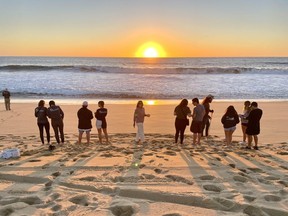Conservation-minded tourists help baby sea turtles make their way to the Pacific in Cabo San Lucas

Reviews and recommendations are unbiased and products are independently selected. Postmedia may earn an affiliate commission from purchases made through links on this page.
We obediently stand in a straight line parallel to the Pacific Ocean at sunset.
Recommended Videos
When instructed, everyone in the group drops to their knees on the beach.
When told to do so, we tip the wooden bowls we have cupped in our hands gently toward the sand. It’s as if we’re taking part in an ancient religious ceremony, at one with nature and the universe.

And it is indeed spiritual, divine and sacred. Because, as we do so, the baby olive ridley sea turtle in the bowl tentatively takes his first awkward flipper-assisted descent on the damp sand.
Golfina, as I’ve nicknamed my turtle after the word for olive ridley in Spanish, weighs in at about 25 grams and is the size of a Ping-Pong ball. Almost immediately, he makes a dash toward the Pacific, his little flippers and light body leaving faint smiley face patterns in the sand.

But, soon enough he seems to tire out, take a rest, move sideways for a bit and then recalibrates to head toward the water. In the 15 minutes it takes him to cover the 12 metres to the ocean’s edge, the waves have kicked up a bit and eventually a rush of water sweeps Golfina out to sea. I can’t help but applaud and feel proud.
My little guy has made it, against the odds, hopefully to a life of 80 long years in the Pacific, swimming gracefully, munching on jellyfish, seagrass and snails and mating with female olive ridleys to perpetuate the species.

Each of the 12 people in our group will repeat this eco-exercise four times, releasing 48 baby turtles to the future.
We use bowls the marine biologists put baby turtles in for us with rubber-gloved hands because tourists aren’t allowed to actually handle the delicate reptiles. It will take an hour — and by this time full darkness — for the last of the turtles to disappear into the ocean.

The conservation and education built right into the Rancho Carisuva program also appealed to us.
As such, we spend an hour with marine biologists Alejandro Rodriguez and Patrick Madrigal before the actual release to learn about sea turtles, how the odds are stacked against them and how the Rancho Carisuva program gives them a fighting chance.
Rancho Carisuva is authorized by the Mexican government to carefully dig up nests after mother turtles lay 100 or so eggs in the sand of 2.5-kilometre-long Pozo de Cota Beach and relocate them to its 60-by-20-metre, fenced-in “turtle corral.”
The nests are protected there from vehicles that can drive on the beach, poachers and an array of predators from seagulls and eagles to crabs and coyotes.
The nests are also covered in plastic or Styrofoam in an effort to keep the perfect incubation temperature of 26C to 32C so baby turtles can hatch 45 to 70 days later.

In all, this season, Rancho Carisuva relocated 290 nests and will release about 34,000 baby turtles with the aid of conservation-minded tourists.
Rancho Carisuva’s release program has about a 90 per cent success rate of getting baby turtles into the ocean.
In the wild, that percentage is only about 40 per cent with the majority of baby turtles picked off by predators or dying while following light pollution rather than the setting sun or moon that leads them to the ocean.
Even if they do reach the ocean, only one in about 1,000 baby turtles will make it to breeding age of 13 to 20 years old.
“We need tourists to sponsor our efforts by participating in our Turtle Release Conservation Program,” explained Rodriguez.
“If you feel empathy for your turtles, and I know you will, then I’m sure you’ll tell everyone you know about turtle conservation.”
My wife and I certainly are.